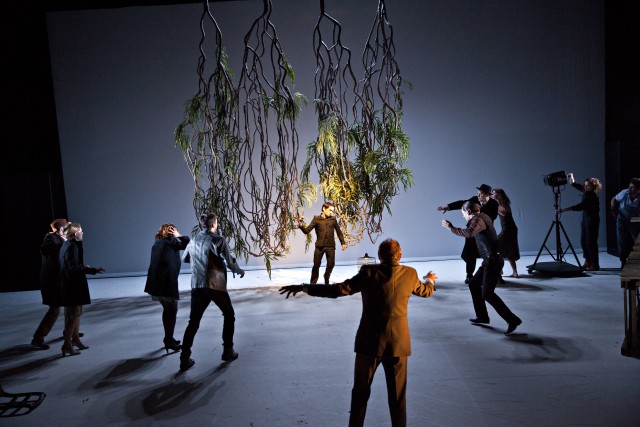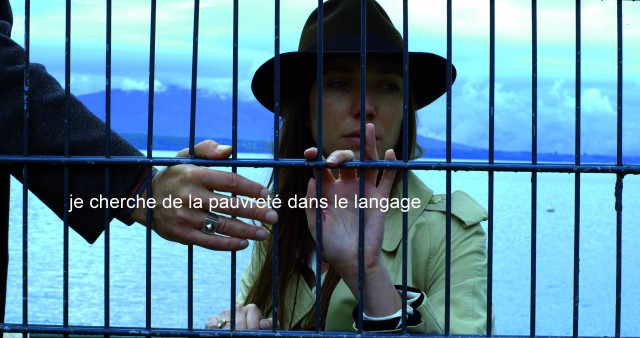
Jean-Luc Godard’s GOODBYE TO LANGUAGE speaks for itself
GOODBYE TO LANGUAGE (ADIEU AU LANGAGE) (Jean-Luc Godard, 2014)
Film Society of Lincoln Center, Elinor Bunin Munroe Film Center, Francesca Beale Theater, 144 West 65th St., 212-875-5050
IFC Center, 323 Sixth Ave. at West Third St., 212-924-7771
Opens Wednesday, October 29
212-875-5050
www.kinolorber.com
 After the New York Film Festival advance press screening of Jean-Luc Godard’s 3D Goodbye to Language, a colleague turned to me and said, “If this was Godard’s first film, he would never have had a career.” While I don’t know whether that might be true, I do know that Goodbye to Language is the 3D flick Godard was born to make, a 3D movie that couldn’t have come from anyone else. What’s it about? I have no idea. Well, that’s not exactly right. It’s about everything, and it’s about nothing. It’s about the art of filmmaking. It’s about the authority of the state and freedom. It’s about extramarital affairs. It’s about seventy minutes long. It’s about communication in the digital age. (Surprise! Godard does not appear to be a fan of the cell phone and Yahoo!) And it’s about a cute dog (which happens to be his own mutt, Miéville, named after his longtime partner, Anne-Marie Miéville). In the purposefully abstruse press notes, Godard, now eighty-three, describes it thusly: “the idea is simple / a married woman and a single man meet / they love, they argue, fists fly / a dog strays between town and country / the seasons pass / the man and woman meet again / the dog finds itself between them / the other is in one / the one is in the other / and they are three / the former husband shatters everything / a second film begins / the same as the first / and yet not / from the human race we pass to metaphor / this ends in barking / and a baby’s cries.” Yes, it’s all as simple as that. Or maybe not.
After the New York Film Festival advance press screening of Jean-Luc Godard’s 3D Goodbye to Language, a colleague turned to me and said, “If this was Godard’s first film, he would never have had a career.” While I don’t know whether that might be true, I do know that Goodbye to Language is the 3D flick Godard was born to make, a 3D movie that couldn’t have come from anyone else. What’s it about? I have no idea. Well, that’s not exactly right. It’s about everything, and it’s about nothing. It’s about the art of filmmaking. It’s about the authority of the state and freedom. It’s about extramarital affairs. It’s about seventy minutes long. It’s about communication in the digital age. (Surprise! Godard does not appear to be a fan of the cell phone and Yahoo!) And it’s about a cute dog (which happens to be his own mutt, Miéville, named after his longtime partner, Anne-Marie Miéville). In the purposefully abstruse press notes, Godard, now eighty-three, describes it thusly: “the idea is simple / a married woman and a single man meet / they love, they argue, fists fly / a dog strays between town and country / the seasons pass / the man and woman meet again / the dog finds itself between them / the other is in one / the one is in the other / and they are three / the former husband shatters everything / a second film begins / the same as the first / and yet not / from the human race we pass to metaphor / this ends in barking / and a baby’s cries.” Yes, it’s all as simple as that. Or maybe not.
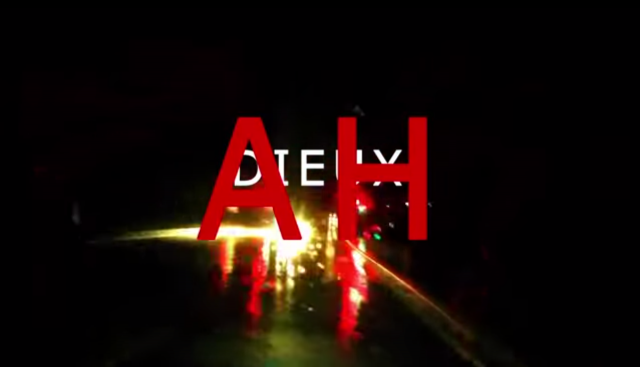
Jean-Luc Godard has fun with 3D in GOODBYE TO LANGUAGE
Godard divides the film into sections labeled “La Nature” and “La Métaphore,” cutting between several ongoing narratives, from people reading Dostoyevsky, Pound, and Solzhenitsyn at an outdoor café to an often naked man and woman in a kitchen to clips of such old movies as Dr. Jekyll and Mr. Hyde and The Snows of Kilimanjaro to Lord Byron and the Shelleys on Lake Geneva. Did I say “narrative”? It’s not really a narrative but instead storytelling as only Godard can do it, and this time in 3D, with the help of cinematographer Fabrice Aragno. Godard has a blast with the medium, which he previously used in a pair of recent shorts. He has fun — and so do we — as he toys with the name of the film and the idea of saying farewell (he plays with the French title, Adieu au langage, forming such puns as “Ah, dieu” and “Ah, dieux,” making the most of 3D layering); creates superimpositions and fast-moving shots that blur the image, making the glasses worthless; changes from sharp color to black-and-white to wild pastel-like bursts of red, blue, and green; evokes various genres, with mystery men in suits and gunshots that might or might not involve kidnapping and murder; and even gets a kick out of where he places the subtitles. These games are very funny, as is the voiceover narration, which includes philosophy from such diverse sources as Jacques Ellul (his essay “The Victory of Hitler”) and Claude Monet (“Paint not what we see, for we see nothing, but paint that we don’t see”). And for those who, like my colleague, believe the film to be crap, Godard even shows the man sitting on the bowl, his girlfriend in the bathroom with him, directly referencing Rodin’s The Thinker and talking about “poop” as he noisily evacuates his bowels. So, in the end, what is Godard saying farewell to? Might this be his last film? Is he saying goodbye to the old ways we communicated? Is he bidding adieu to humanity, leaving the future for the dogs, the trees, and the ocean? Does it matter? A hit at Cannes, Goodbye to Language opens October 29 at the IFC Center and Lincoln Center after screening at the New York Film Festival earlier in the month. You can check out the NSFW French trailer here.
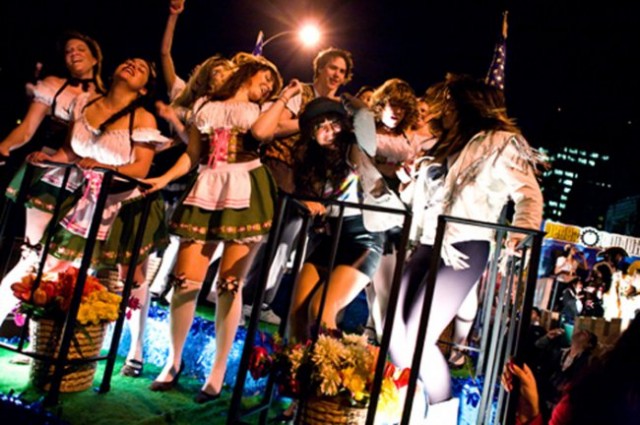
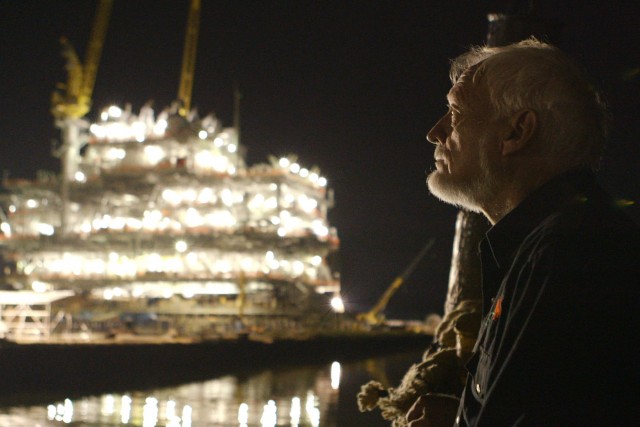
 Shortly after the fatal Deepwater Horizon oil rig explosion on April 20, 2010, dumped more than two hundred million gallons of BP oil into the Gulf of Mexico, Alabama native and award-winning documentarian Margaret Brown (The Order of Myths, Be Here to Love Me: A Film about Townes Van Zandt) returned to the Gulf Coast, where she was raised, in order to make a very personal film about the disaster. But she ended up with so much more in The Great Invisible, a powerful, infuriating exploration of the tragedy and its lingering effects on the environment and local communities in Alabama, Louisiana, and Texas. Showing that the calamity is far from over, Brown speaks with survivor Douglas Brown, the chief mechanic on the rig who talks poignantly about what happened, sharing footage he took of the rig prior to the explosion; survivor Stephen Stone, a roustabout on the rig who now suffers from PTSD; attorney Keith Jones, whose son, Gordon, was one of the eleven workers killed in the explosion, and is now leading the fight to get justice for the victims in court; Latham Smith, a tugboat captain who was called in to help with the cleanup; oil and gas industry veteran Bob Cavnar, author of Disaster on the Horizon: High Stakes, High Risks, and the Story Behind the Deepwater Well Blowout; Roosevelt Harris, who volunteers for the Hemley Road Church of Christ Mobile Food Pantry, delivering food and emotional support to families whose livelihoods have been impacted by the disaster; a group of oil industry executives chatting among themselves; and Kenneth Feinberg, the dispute resolution specialist in charge of administering the BP Deepwater Horizon Disaster Victim Compensation Fund, which has not exactly made much of a difference. BP refused to participate in the film.
Shortly after the fatal Deepwater Horizon oil rig explosion on April 20, 2010, dumped more than two hundred million gallons of BP oil into the Gulf of Mexico, Alabama native and award-winning documentarian Margaret Brown (The Order of Myths, Be Here to Love Me: A Film about Townes Van Zandt) returned to the Gulf Coast, where she was raised, in order to make a very personal film about the disaster. But she ended up with so much more in The Great Invisible, a powerful, infuriating exploration of the tragedy and its lingering effects on the environment and local communities in Alabama, Louisiana, and Texas. Showing that the calamity is far from over, Brown speaks with survivor Douglas Brown, the chief mechanic on the rig who talks poignantly about what happened, sharing footage he took of the rig prior to the explosion; survivor Stephen Stone, a roustabout on the rig who now suffers from PTSD; attorney Keith Jones, whose son, Gordon, was one of the eleven workers killed in the explosion, and is now leading the fight to get justice for the victims in court; Latham Smith, a tugboat captain who was called in to help with the cleanup; oil and gas industry veteran Bob Cavnar, author of Disaster on the Horizon: High Stakes, High Risks, and the Story Behind the Deepwater Well Blowout; Roosevelt Harris, who volunteers for the Hemley Road Church of Christ Mobile Food Pantry, delivering food and emotional support to families whose livelihoods have been impacted by the disaster; a group of oil industry executives chatting among themselves; and Kenneth Feinberg, the dispute resolution specialist in charge of administering the BP Deepwater Horizon Disaster Victim Compensation Fund, which has not exactly made much of a difference. BP refused to participate in the film.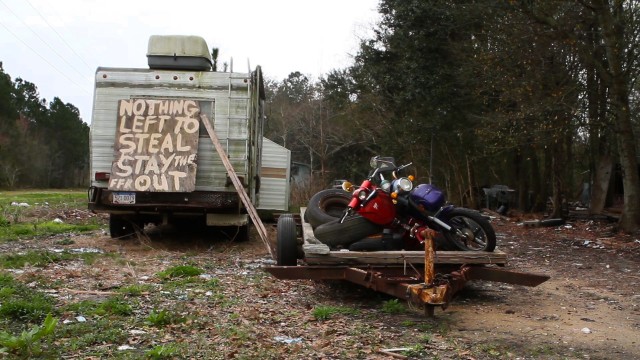

 After the New York Film Festival advance press screening of Jean-Luc Godard’s 3D Goodbye to Language, a colleague turned to me and said, “If this was Godard’s first film, he would never have had a career.” While I don’t know whether that might be true, I do know that Goodbye to Language is the 3D flick Godard was born to make, a 3D movie that couldn’t have come from anyone else. What’s it about? I have no idea. Well, that’s not exactly right. It’s about everything, and it’s about nothing. It’s about the art of filmmaking. It’s about the authority of the state and freedom. It’s about extramarital affairs. It’s about seventy minutes long. It’s about communication in the digital age. (Surprise! Godard does not appear to be a fan of the cell phone and Yahoo!) And it’s about a cute dog (which happens to be his own mutt, Miéville, named after his longtime partner, Anne-Marie Miéville). In the purposefully abstruse press notes, Godard, now eighty-three, describes it thusly: “the idea is simple / a married woman and a single man meet / they love, they argue, fists fly / a dog strays between town and country / the seasons pass / the man and woman meet again / the dog finds itself between them / the other is in one / the one is in the other / and they are three / the former husband shatters everything / a second film begins / the same as the first / and yet not / from the human race we pass to metaphor / this ends in barking / and a baby’s cries.” Yes, it’s all as simple as that. Or maybe not.
After the New York Film Festival advance press screening of Jean-Luc Godard’s 3D Goodbye to Language, a colleague turned to me and said, “If this was Godard’s first film, he would never have had a career.” While I don’t know whether that might be true, I do know that Goodbye to Language is the 3D flick Godard was born to make, a 3D movie that couldn’t have come from anyone else. What’s it about? I have no idea. Well, that’s not exactly right. It’s about everything, and it’s about nothing. It’s about the art of filmmaking. It’s about the authority of the state and freedom. It’s about extramarital affairs. It’s about seventy minutes long. It’s about communication in the digital age. (Surprise! Godard does not appear to be a fan of the cell phone and Yahoo!) And it’s about a cute dog (which happens to be his own mutt, Miéville, named after his longtime partner, Anne-Marie Miéville). In the purposefully abstruse press notes, Godard, now eighty-three, describes it thusly: “the idea is simple / a married woman and a single man meet / they love, they argue, fists fly / a dog strays between town and country / the seasons pass / the man and woman meet again / the dog finds itself between them / the other is in one / the one is in the other / and they are three / the former husband shatters everything / a second film begins / the same as the first / and yet not / from the human race we pass to metaphor / this ends in barking / and a baby’s cries.” Yes, it’s all as simple as that. Or maybe not.

 Winner of the FIPRESCI Prize at the Cannes Film Festival and a selection of the New York Film Festival, Climates is a beautifully elegiac look at a desperate relationship set in modern-day Turkey. The film opens with Isa (writer-director Nuri Bilge Ceylan) and Bahar (Ebru Ceylan, Nuri’s real-life wife) visiting desert ruins. As he walks among ancient pillars, taking photos, she watches him from a distance; the silence is deafening. Later, on a beach, they agree to part ways; while he heads back into the arms of Serap (Nazan Kesal), a friend’s lover, she takes a job on a faraway television program, set in the bitter cold and snow. But Isa still can’t get the younger Bahar out of his mind. Climates features long scenes of little dialogue, with cinematographer Gökhan Tiryaki alternating extreme close-ups with gorgeous, nearly empty landscapes, shot in HD digital video, with a haunting piano-based score. Ceylan’s follow-up to Distant, which won the 2003 Jury Grand Prix at Cannes, Climates is a wrenching, challenging tale that will leave audiences emotionally exhausted. Climates is being shown at MoMA on October 30 at 7:30 and November 5 at 4:00 as part of the “Filmmaker in Focus” look at Ceylan, who will introduce the the October 30 screening with actor Mehmet Eryilmaz. The week-long festival runs October 29 to November 5 and also includes Ceylan’s latest film, Kis uykusu (Winter Sleep), in addition to 2011’s Bir Zamanlar Anadolu’da (Once Upon a Time in Anatolia), 2008’s Üç maymun (Three Monkeys), 2002s Uzak (Distant), 1999’s Mayis sikintisi (Clouds of May), and 1997’s Kasaba (The Small Town).
Winner of the FIPRESCI Prize at the Cannes Film Festival and a selection of the New York Film Festival, Climates is a beautifully elegiac look at a desperate relationship set in modern-day Turkey. The film opens with Isa (writer-director Nuri Bilge Ceylan) and Bahar (Ebru Ceylan, Nuri’s real-life wife) visiting desert ruins. As he walks among ancient pillars, taking photos, she watches him from a distance; the silence is deafening. Later, on a beach, they agree to part ways; while he heads back into the arms of Serap (Nazan Kesal), a friend’s lover, she takes a job on a faraway television program, set in the bitter cold and snow. But Isa still can’t get the younger Bahar out of his mind. Climates features long scenes of little dialogue, with cinematographer Gökhan Tiryaki alternating extreme close-ups with gorgeous, nearly empty landscapes, shot in HD digital video, with a haunting piano-based score. Ceylan’s follow-up to Distant, which won the 2003 Jury Grand Prix at Cannes, Climates is a wrenching, challenging tale that will leave audiences emotionally exhausted. Climates is being shown at MoMA on October 30 at 7:30 and November 5 at 4:00 as part of the “Filmmaker in Focus” look at Ceylan, who will introduce the the October 30 screening with actor Mehmet Eryilmaz. The week-long festival runs October 29 to November 5 and also includes Ceylan’s latest film, Kis uykusu (Winter Sleep), in addition to 2011’s Bir Zamanlar Anadolu’da (Once Upon a Time in Anatolia), 2008’s Üç maymun (Three Monkeys), 2002s Uzak (Distant), 1999’s Mayis sikintisi (Clouds of May), and 1997’s Kasaba (The Small Town).